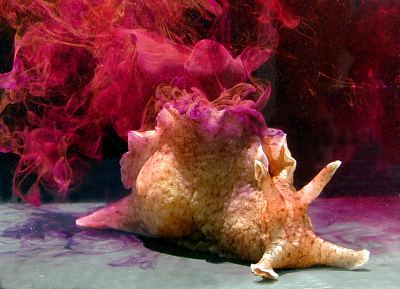- Aplysiidae
Taxobox
name = "Aplysiidae"

image_width = 200px
image_caption = "Aplysia californica ", a typical sea hare, shown here releasing a cloud of purple pigment, probably as a reaction to being poked or prodded.
regnum =Animal ia
phylum =Mollusca
classis =Gastropoda
subclassis =Orthogastropoda
superordo =Heterobranchia
ordo =Opisthobranchia
subordo =Anaspidea (= Aplysiomorpha)
superfamilia = Aplysioidea
familia = Aplysiidae
familia_authority =Rafinesque , 1815
subdivision_ranks = Genera
subdivision = See text.The
superfamily Aplysioidea contains only one family, the Aplysiidae; thesea hare s. They are one kind of seaslug .These animals are commonly called sea hares. This is because, unlike most sea slugs, they are often quite large, and underwater their rounded body shape and the long
rhinophores on their head mean that their overall shape resembles that of a sitting rabbit orhare .Sea hares are in fact
opisthobranch gastropod mollusk s, shell-less seasnail s, and some species are extremely large. Arguably the largest living gastropod species is the Californian black sea hare, "Aplysia vaccaria".In
Australia sea hares are sometimes known as "beach blobbies". Sea hares do sometimes become stranded on beaches, and when this happens, they contract as much as possible to minimize desiccation, and when the sea hare's body is not fully supported by water, the rhinophores collapse and the animal looks more blob-like.Description
Members of the Aplysiidae have an atrophied inner shell (in contrast with the
nudibranch s, which have no shell at all). In "Aplysia" and "Syphonota", this shell is a soft flattened plate over thevisceral rear end, where it is fully or partially enclosed in the mantle skin. In "Dolabella auricularia", the shell is ear-shaped. The shell is completely absent in the genera "Bursatella" and "Stylocheilus".They are rather large animals. Their length varies between 20 cm and 75 cm ("Aplysia vaccaria"), and they can weigh well over 2 kg. They are cosmopolitan and found in temperate and tropical seas, inhabiting shallow coastal areas and sheltered bays, thick with vegetation.
The Aplysiidae are herbivorous, eating a variety of red, green or brown
alga e and eelgrass. Their color is diet-derived from the pigments of the algae. They concentrate the toxins found on algae.Defenses
Some species spout ink when disturbed or attacked, and they may also swim (rather than crawl) away, using their broad wing-like flaps or
parapodia .Sea hares have two main secretory glands in their mantle cavity.
* purple gland: lying on top of the mantle cavity, above the gill. It gives off a red or purple fluid, or, in some species, a white ink.
* opaline gland: situated on the floor of the mantle cavity, beneath the gill. It gives off a white opaque secretion.The genus "
Aplysia " has proved useful as a model inneurobiology for the study ofelectrical synapse s, which mediate the release of the clouds of ink (Kandel et al, 2000).Mating habits
Sea hares are
hermaphrodite s, with fully functional male and female reproductive organs. Thepenis is on the right side of the head while thevagina is situated in the mantle cavity, beneath the shell, deep down between the parapodia. It is therefore physically impossible for mating partners to act as both male and female at the same time.They have unusual mating habits: they can mate in pairs with one acting as a male, the other as a female, but they commonly occur in quite crowded numbers during the mating season, and this often leads to chains of three or more sea hares mating together. The one at the front acts as a female and the one at the back as a male. The animal(s) in between are acting as both males and females, in other words, the animal receiving sperm passes its own sperm to a third sea hare.
Predators
Predator s include pycnogonid sea spiders,wrasse s andsea turtle s.Taxonomy
The authority of this family is still somewhat in dispute. The family was incorrectly originally spelled as Laplysiana. This was a Latinized form of the original common name "les Laplysiens" as described in "Philosophie zoologique", 1:320 by Lamarck in 1809 cite book | title=Philosophize zoologique| last=Lamarck| first=J.B.| year=1809| pages=428| publisher=Dentu| location=Paris] . Rafinesque introduced the new name Laplysinia in 1815. In 2001 Bouchet & Rocroi advocated the attribution of the name Aplysiidae to Lamarck. cite journal | author=Bouchet, P. & J.P. Rocroi| title=Corrections of Authorship and date for gastropod (Mollusca) family-group names placed on the Official List and Official Index| journal=Bulletin of Zoological Nomenclature| year=2001| volume=58| issue=3| pages=170–178]
Subfamilies
Classification after N.B. Eales (1984) cite journal | authorlink=Eales N.B.| title=Notes on cephalaspideans| journal=Opisthobranch| year=1984| volume=16| issue=3| pages=26]
*Aplysiinae Lamarck, 1809
*Dolabellinae Pilsbry, 1895
*Dolabriferinae Pilsbry, 1895
*Notarchinae Mazzarelli, 1893Genera
* "
Aplysia "
* "Bursatella"
* "Dolabella"
* "Dolabrifera "
* "Notarchus "
* "Petalifera "
* "Phyllaplysia "
* "Syphonota"
* "Stylocheilus "Footnotes
References
* Kandel, E.R. (1979) "Behavioural Biology of Aplysia". San Francisco, W.H.Freeman & Co. 463pp.
* Kandel E.R., Schwartz, J.H., Jessell, T.M. (2000). "Principles of Neural Science ", 4th ed., New York, McGraw-Hill 180pp.External links
* http://www.seaslugforum.net
Wikimedia Foundation. 2010.
